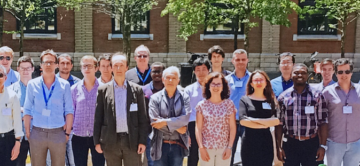Daniel Chen joined TSE in 2016 from ETH Zurich and works at the crossroads between economics and law. Five years ago, he successfully gathered an immense dataset on more than 380 000 US federal justice cases, and 1 million votes by federal judges. He has since worked tirelessly to exploit and understand this precious mine of information, revealing how economics, emotions and random events can influence judges’ verdicts.
How do we make decisions? Do we consider only the consequences of our actions or are we acting per our moral values? This age-old philosophical question has yet to be answered but Daniel thinks he may have part of an answer. “In the US, judges are extremely respected and have a lot of decision power. I tried to understand how they are making decisions and how those decisions are altered by outside factors,” he explains. “For instance, when the US federal court ruled against Donald Trump’s proposed travel ban, how did they make the decision which had a wide array of effects and consequences?”
The researcher and his colleagues targeted US federal court decisions since 1891 for analysis, in the belief that they represent a natural laboratory for the investigation of wider questions about human behavior. The roughly 800 US federal judges are appointed for life and are randomly assigned to cases, along with two of their peers. “This is the perfect situation to monitor how decision-making evolves and how peer influence works,” says Daniel.
Starting 1976, US federal judges began receiving economics training, and by 1990, 40% of federal judges had attended those classes. Daniel’s data suggests that these seminars may have had dramatic effects: judges subsequently favored more conservative verdicts and were more opposed to regulation. Daniel has also observed this trend in the decisions of judges who didn’t receive any training but participated in the same cases as judges who did: “The fast pervasion of economics literature language, and especially of the word ‘deterrence’, into judicial reasoning in their written opinions is an incredible indicator of the impact those seminars had on judges.”
With more than four terabytes of data and complex modelling, Daniel and his co-authors have shown that economics training can change the way we understand issues and make decisions. These changes also seem to be passed on to ‘untrained’ peers as soon as they work together. The spread of technical terms from economics into juridical verdicts is another indicator of the powerful, fast and lasting impact of economic knowledge on people’s perspectives.
Daniel has also tried to understand what other parameters could play a role in influencing judges’ verdicts: “The idea was to try to understand whether judges made consistent decisions or if their verdicts could be emotionally impacted.”
Across different courts, Daniel found evidence of many surprising details that can influence judges’ decisions. For instance, judges were on average more lenient on the day after their favorite team won a match. Sentences of people who were tried on their birthday were systematically much lower, but only if the defendant was present during the trial. Even the level of masculinity of the lawyer’s voice appears to influence trial outcomes.
“It’s clear that economics training changed judges’ perception of their cases, but it also looks like external factors have a profound impact,” Daniel concludes. “With all these factors considered, our models can predict the outcomes of a trial much more precisely than with more traditional methods.”
Daniel will continue to work with this huge database: “Finding so many different correlations demonstrate that judges are indeed humans and that their emotions at the time of a verdict play a role. This hints that we make decisions both with a consequentialist point of view and a deontological one, and gives us a better understanding of the complexity of decision-making processes.”



